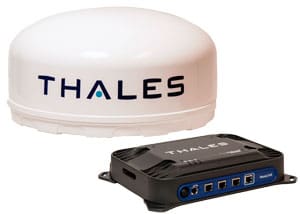When long-range cruising, it’s nice to get away from it all — but some of us still must remain connected. We are spoiled on land with Internet access at speeds of 300 Mbps for prices as low as $50 a month. The same speed at sea may cost you $50,000. Therein lies the challenge: How can we surf the Internet at sea without blowing the entire communications budget?
The fishing and shipping industries use VSAT broadband services today, but these systems start at $25,000, may run $1,000 or more for airtime, and are too large for most users. Future services sound fantastic — like SpaceX’s Starlink or Amazon’s Project Kuiper — but are not ready for prime time yet. This means your best option is still L-band services from Iridium or Inmarsat.
For global users, Iridium Certus is the ideal choice. Iridium recently upgraded their entire constellation of 66 satellites to a new network that offers speeds up to 704 kbps. Even though this speed is much like the DSL of yesterday, it is adequate for the communications many require while at sea, including light Internet browsing, weather and unlimited email. You can expect to pay at least $200 dollars a month for airtime and service fees.
For coastal users, Inmarsat Fleet One can’t be beat. Service providers offer an unlimited data plan for sailors for as low as $229 a month. At the start of the month, you can expect 150 kbps — but after you blow through 30 MB of data, your Internet speed will be throttled to 32 kbps. Don’t worry about only having 32 kbps to do your work, though; the email programs offered by satellite airtime providers were designed for speeds of 2,400 baud, so they work very well even at the slower speeds.
When you purchase either Iridium or Inmarsat services, it is best to source your equipment from a marine electronics shop. Your local shop can provide the expertise needed for an installation, or to guide you through an installation. There are four main manufacturers to choose from, as well as different configurations that should be discussed. The systems can be connected directly to a 12- or 24-volt power source. There are also many options for connecting phones, including your smartphone, an SIP phone or the manufacturer’s handset with display.
Finally, don’t forget your firewall! Since L-band services are still charged by the volume of data you use — or throttled when you reach a cap — it is important to use an appliance that will block unwanted traffic. Without a firewall, just an operating system software update alone can cost you $1,000. With the firewall, you can safely connect a computer or use your smartphone without the need to worry about background data traffic.
One other stopgap measure is to have your airtime service provider set up an automatic temporary suspension based on your usage. With the Fleet One coastal plan, there is no need to stop data usage since the coastal plan is unlimited, but global Fleet One or Iridium plans should include a service suspension at a dollar threshold that makes sense for your budget.
Dave Brengelmann is an avid sailor in Puget Sound and the Gulf Islands. He’s been in the satellite phone business for over 25 years and works for Network Innovations (daveb@networkinv.com).

